List of Authors
>>About this blog
Recent blog post
|
[Sumida Fireworks]
February 21, 2019 09:00
The fifth episode of Kyobashi Monogatari. It's a continuation from the last time.
Until the last time → 【①】【②】【③】【④】
Minami Temmacho, where the remnants of the Taisho era remained even after the Great Kanto Earthquake. In this city, which is lined with modern buildings, we decided to continue to look at the reconstruction of Ginza from a high place. If you sit in a chair, the view looks very pleasant. Entering the Showa era, the cityscape of Ginza Street has also clearly changed.
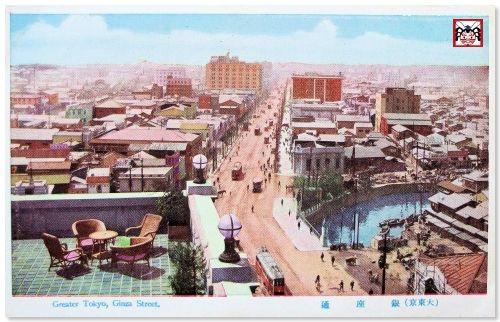
On the left of the street, a department store in Matsuya has already opened. In the back, you can see Matsuzakaya slightly, and the reconstruction of the city of Ginza seems to be progressing rapidly, led by these two department stores.
On the other hand, the scenery of Minami Temmacho around 1928. The streetcars and shared buses are shown on the street, indicating that they are booming. The renovation of the Hoshi Pharmaceutical building has begun, and the Katakurakan on the leftmost part has been expanded.
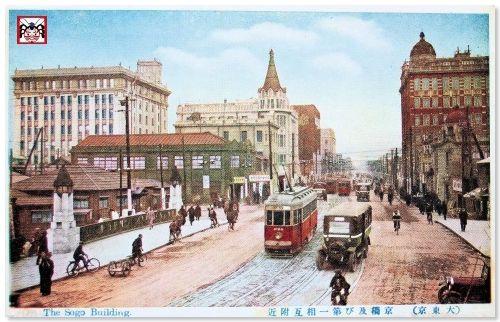
In the fall of 1928, Emperor Showa's memorial service (gratitude) is held, and a memorial tower is set up in Kyobashi. The great scripture is a series of ceremonies, such as the throne, Great Thanksgiving Ceremony. At the time of Emperor Taisho, what was done in 1915 was introduced in Kyobashi Monogatari 2.
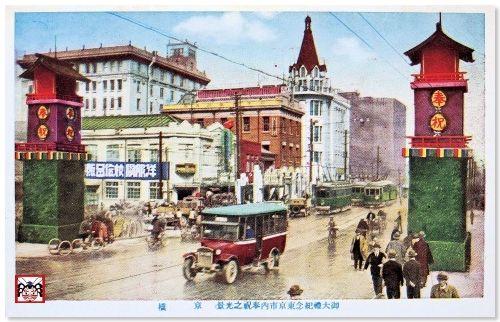
This year 2019 is a memorable year, and as you know, the throne will take place on October 22. This year's throne is held in Tokyo in the same way as in the Heisei era, but it is said that it was held at the Kyoto Imperial Palace during the Showa and Taisho eras.
In 1930, seven years have passed since the earthquake. There is a break in the earthquake reconstruction project.
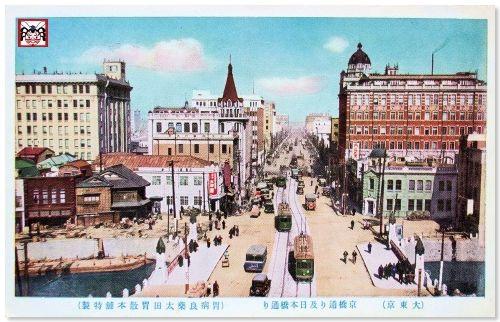 Hoshi Pharmaceutical buildings, which had been damaged by the earthquake, have been renewed, and the reconstruction of the city of Minami Temmacho has ended for the time being. Nevertheless, the cityscape of Minami Temmacho, which retains the remnants of the Taisho era. People walking on Ginza Street may have felt a kind of nostalgia. Hoshi Pharmaceutical buildings, which had been damaged by the earthquake, have been renewed, and the reconstruction of the city of Minami Temmacho has ended for the time being. Nevertheless, the cityscape of Minami Temmacho, which retains the remnants of the Taisho era. People walking on Ginza Street may have felt a kind of nostalgia.
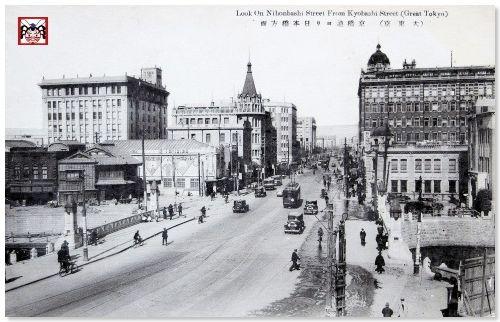
Then, in late March 1930, the Imperial City Reconstruction Festival will be held. Many citizens rush to Ginza Street and share the joy of reconstruction.
The main pillar of Kyobashi facing the heavens and the tower of the building in Minami Temmacho. A double pole of a tram in the commemorative celebration tower. The place where the crowd standing in front of it looks at is the city of Ginza that has been reconstructed.
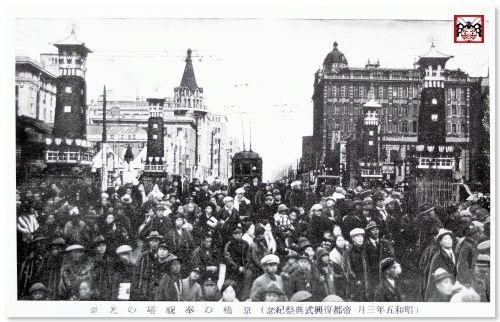
The whole city of Minami Temmacho, which has been watching Ginza until now, seems to be blessing the reconstructed city of Ginza by raising both hands toward Ginza Street, saying "Hanzai!"
If you can go back in time in the past only once in Chuo-ku, when and where would you like to go? 。 I would like to designate somewhere in this wonderful photo and look at Ginza Street. The tongari roof of Daido Life Building in the upper left looks good.
But after all, it might be better to look down on Ginza Street from the tower of Daiichi Mutual Hall in the upper right.
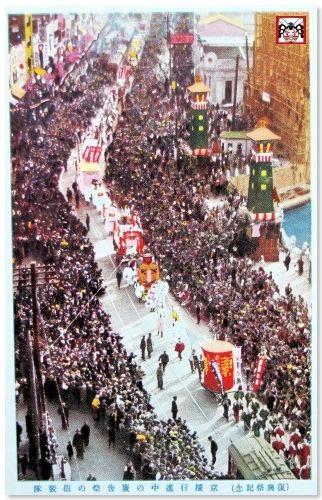 This year when Ginza Mitsukoshi also opened at the 4-chome intersection. There was a change in the town of Ginza. Ginza, which was up to 4-chome, expanded to 8-chome, and the location of Owaricho, where the Matsuzakaya Ginza store was built, has been changed to Ginza 6-chome. This year when Ginza Mitsukoshi also opened at the 4-chome intersection. There was a change in the town of Ginza. Ginza, which was up to 4-chome, expanded to 8-chome, and the location of Owaricho, where the Matsuzakaya Ginza store was built, has been changed to Ginza 6-chome.
The following year, Showa 6 (1931). The same thing happens in Minami Temmacho.
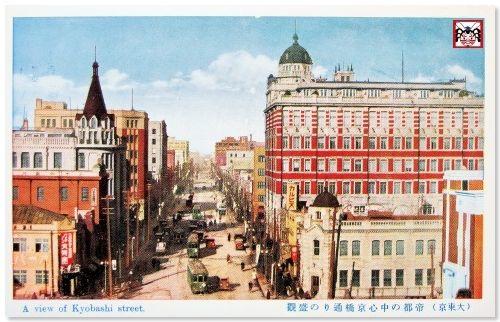
Just as the bridge stopped giboshi since Edo, Minami Temmacho and the surrounding cities also decided to stop the name of the town since Edo. It will be a manifestation of the consciousness of moving toward a new era. The new town name I chose is "Kyobashi". It was the moment when the modern city and modern bridges formed during the Taisho era were integrated in both name and reality.
The following year, in 1932, the clock tower of Hattori Clock Store was built at the Ginza 4-chome intersection. On the other hand, on Kyobashi-dori, the Fukutoku Life Building is completed on the left hand side, and the face of the city of Kyobashi changes.
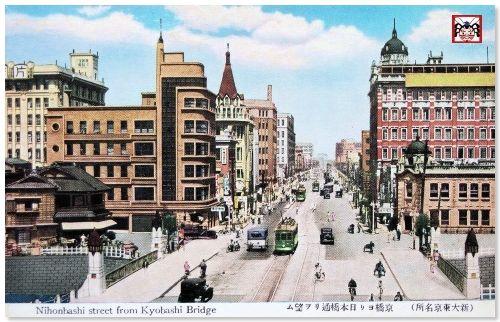
And don't forget that famous building in the city of Kyobashi. This building will be built next to Chiyoda-kan between Hoshi Pharmaceutical and Chiyoda-kan at Kyobashi 2-chome. In the early Showa period, there was a gable roof-style balack and a French restaurant Konosu.
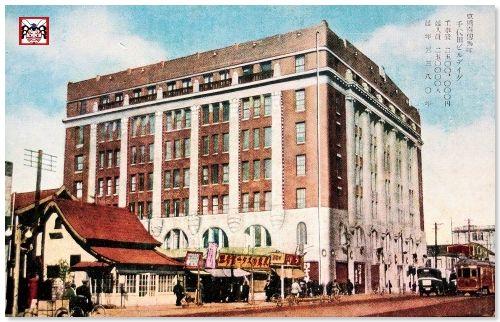
Is it around 1932? If you look at Kyobashi 2-chome from the Daiichi Mutual Hall, you can see that the land was vacant at this point.
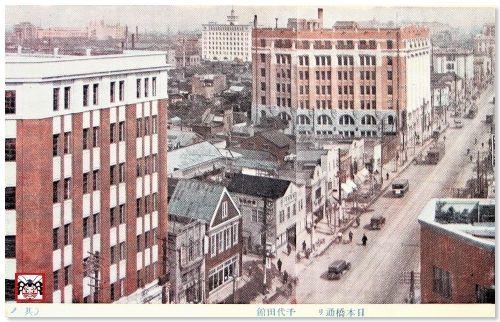
That building is the building of Meijiya. It was completed in 1933 next to Chiyoda-kan. The picture postcard below shows a little Meijiya.
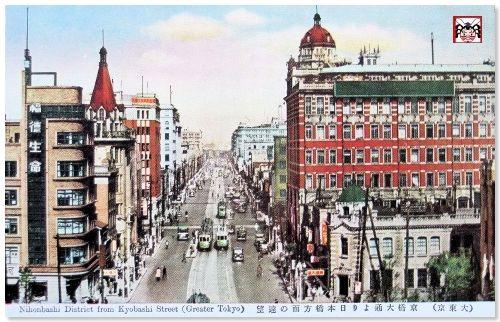
In this way, you can see that the Meijiya building was a latecomer building built in the city of Kyobashi. By the way, I think that the only buildings in this postcard still remain in this Meijiya building and the Nihonbashi Takashimaya, which was completed in the same year, in the back right of the street. In Ginza, the Kyobunkan building was built in the same year, and it still remains.
In addition, this Meijiya building was built by connecting the basement and the subway station, and during construction, a subway ran to Kyobashi Station. Asakusa Kaminoma opened in 1927 and gradually expanded the opening section to Kyobashi Station in December 1932, and Ginza Station in March 1934.
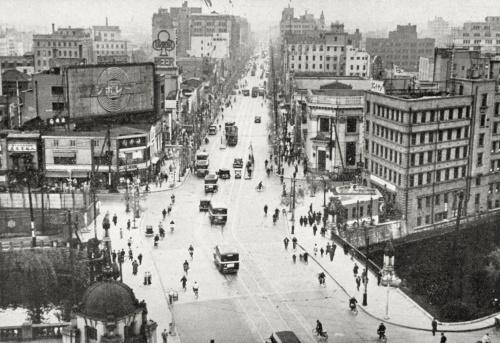
Photo provided: Chuo Ward Kyobashi Library
This street, where department stores have expanded mainly in Ginza and the subway has been opened, attracts new customers and is extremely prosperous. However, the prosperity of Ginza Street means that the role of the town of Kyobashi has been completed, "watching the reconstruction of Ginza."
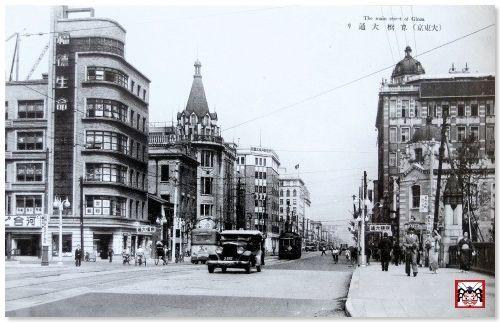
After this, the wartime color became darker and controlled, and I have not been able to find Kyobashi postcards since then. Almost in this form, we entered the Pacific War and ended the war.
And the next time is the last one. Until now, it was a long story from the first to fifth times, but when you click on some of the images, you can see enlarged images and explanatory images. I hope you look back again and look at the next final episode.
Followed.
[Sumida Fireworks]
February 14, 2019 09:00
The fourth episode of Kyobashi Monogatari. It's a continuation from the last time.
Until the last time → Kyobashi Monogatari [1] [2] [3]
This is a postcard depicting the cityscape of Minami Temmacho, which had undergone a major transformation in the Taisho era (around 1921). The postcard says "Kyobashi-dori". Currently, it is called "Chuo-dori", but in old postcards, "Ginza-dori", "Kyobashi-dori" and "Nihonbashi-dori" were printed for each location. The names of each street were sent to all over the country with photos, and the development of Tokyo was visually understood.
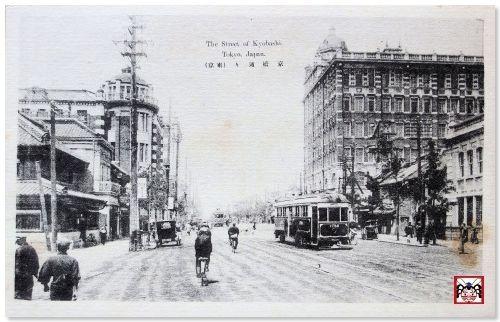
However, Tokyo was attacked by an event on September 1, 1923.
The school on this day was the opening ceremony, Saturday, and the children were trying to eat lunch about their homes. The cause of the damage was fires that occurred in various places after that, rather than the collapse of buildings due to the shaking of the 11:58 earthquake. Minami Temmacho is no exception, and the city is burned.
I see it from around Konyabashi, a little upstream of the Kyobashi River. The daikon riverbank at the end of the revetment of the Kyobashi River has been burned down. However, the large building in Minami Temmacho seems to have not collapsed.
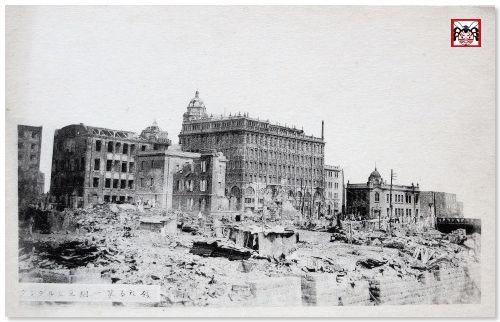
I'll get close to Kyobashi and check it. The postcard below shows the bridge and Minami Temmacho over the Kyobashi River from the Ginza side. Kyobashi survived the collapse, and the buildings of the tall Daiichi Mutual Hall in the center, Daido Life on the left, 34 Bank, and Toyokuni Bank on the right have not collapsed. The "three dome roofs" remained.
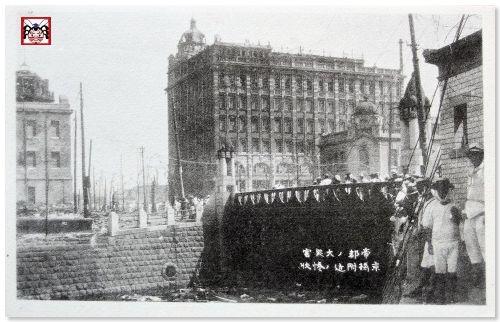
In the Great Kanto Earthquake, many famous buildings collapsed. Ryounkaku (Asakusa 12th floor), which was said to be the tallest, was also damaged, and the first mutual hall in Minami Temmacho replaces the tallest building in this area. After that, the first mutual hall will look at Tokyo, which is recovering, from the highest point.
I will check the status of the damage caused by the earthquake from the first mutual hall. First of all, the opposite side of Ginza is the Nihonbashi area. The town directly below is the current Kyobashi 2-chome, Minami Temmacho 2-3-chome at that time.
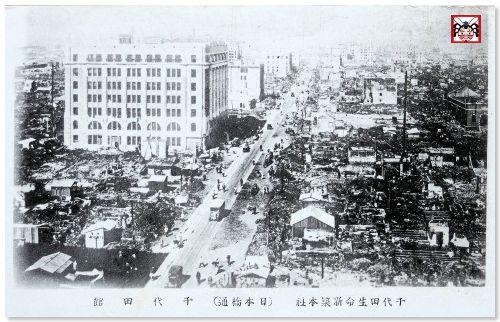
Although it turned into a pile of rubble, the Chiyoda-kan, which was completed three months before the earthquake, did not collapse. The postcard was created by Chiyoda Life Insurance Co. We sent postcards to various places and told them that the head office building had not fallen. It seems that the purpose was to make the contractor feel safe. At that time, there was no radio yet. As information was complicated in various places, postcards functioned greatly as a media that visually conveys information about the earthquake disaster.
On the other hand. This postcard is also a postcard made by Dai-ichi Life Insurance. It will be Kyobashi-dori on September 28, taken from around Chiyoda-kan.
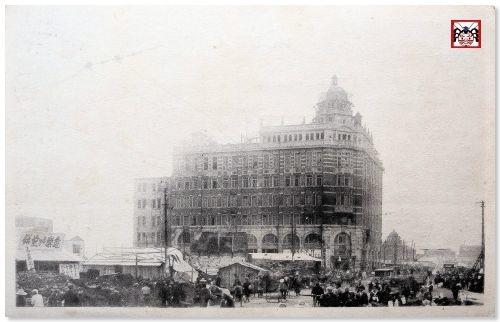
Something like huts and tents are built on the side of the road, and many people gather on the street. It can be seen that it is chaotic, but the power of those who are confronting reconstruction is also transmitted.
Let's check the Ginza area from the first mutual hall. Although rubble is piled up on the side of Kyobashi at the lower right, you can see that the building on the banks of the radish behind it is beginning to build something like Kariya.
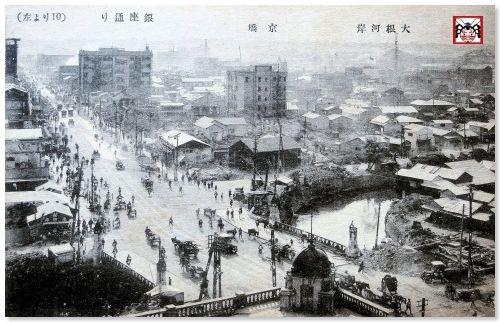
In Hashigami, you can see things like wagons and rear cars, and it is in the middle of restoration. The large building on the right side of the street is the Okura Gumi Main Building, which survived the earthquake. On the left side of the street, you can see a little Matsuya's steel frame, which will open later.
Ginza Street was a luxury city that developed from brick streets in Meiji period. But here the end of that era was announced, and the start of a new city was started.
I'll check the status of other buildings. It is the direction where you can see Tokyo Station in the back. You can also see how the houses are being built and reconstructed.
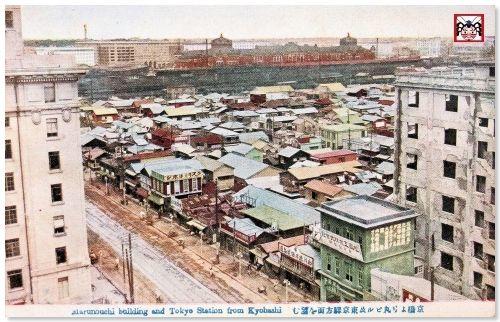 The building on the left is Katakura-kan, and the right is star pharmaceutical with a diagonal window. The Katakura-kan will continue to expand and grow, but the Hoshi Pharmaceutical building has been damaged and will be rebuilt after this. The Kajibashi-dori, which runs in the middle, will be widened by the earthquake reconstruction project. The building on the left is Katakura-kan, and the right is star pharmaceutical with a diagonal window. The Katakura-kan will continue to expand and grow, but the Hoshi Pharmaceutical building has been damaged and will be rebuilt after this. The Kajibashi-dori, which runs in the middle, will be widened by the earthquake reconstruction project.
Due to the Great East Japan Earthquake, the marriage ceremony of His Imperial Highness Higashimiya (later Emperor Showa), which was scheduled to be held in November, has been postponed. He married on January 26 of the following year, celebrated on June 5, and a celebration tower will be built in Kyobashi.
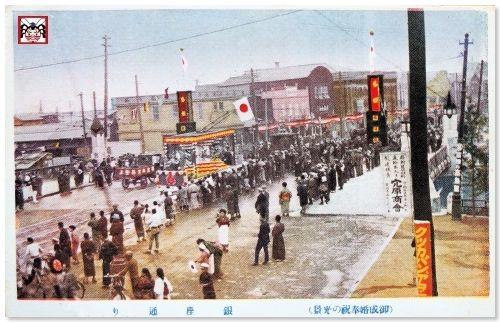
It is a photo of the Ginza area from Minami Temmacho, but you can see that the new cityscape of Ginza has already been shaped. I guess this celebration gave new hope and courage to Ginza Street, which is recovering. Five months later, the department store Matsuzakaya will open in Owaricho on Ginza Street.
On the other hand, Minami Temmacho. Since the large building in this neighborhood did not collapse, from the Ginza side, it seems that the scenery has hardly changed before the earthquake. Actually looking at the postcard, I had a hard time identifying the times before or after the earthquake.

The clues were the letters written on the postcard and the ballaque-style building in front of the left hand. If this building is shown, it will be the scenery of Minami Temmacho after the earthquake.
It was around this time that a lot of shared buses came to be seen. This is the scenery of 1926. This year was also the year when the radio broadcasting started.
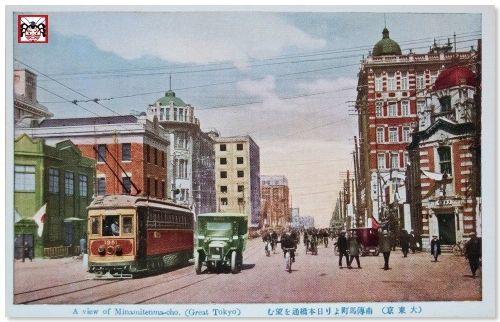
Despite the earthquake, the cityscape of Minami Temmacho, which left the scent of the Taisho era, will enter the era of Showa as if nothing had happened. From the point of view of the city of Ginza, which looks for the best way to be reborn, the streets of Minami Temmacho are nostalgic, seeming to be watching over, and may have looked strange.
But here suddenly a change occurred in the cityscape of Minami Temmacho.
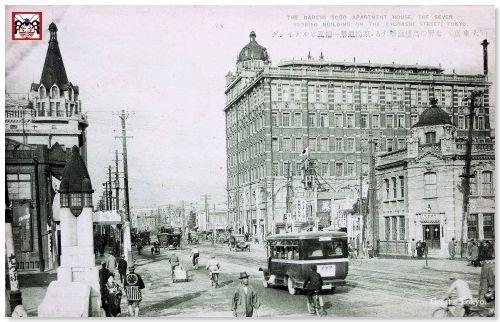
The dome roof of the Daido Life Building on the left stretched out.
This Tongari roof is as if the design of the main pillar of Kyobashi in the Taisho era has been transferred. When replacing the bridge, it would not mean that foresee the future and made the design of the main pillar into a Tongari style. If anything, the city of Minami Temmacho seems to be returning to the old days rather than being reborn.
In any case, I think it is true that the cityscape of Minami Temmacho and the design of Kyobashi have been integrated.
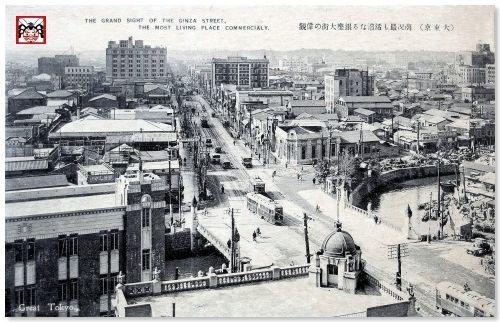
In this way, the cityscape of Minami Temmacho, which survived the Great Kanto Earthquake, inherited the atmosphere of the Taisho era as it was in the Showa era, and continued to watch the city of Ginza, which is recovering.
Followed.
[Sumida Fireworks]
February 10, 2019 18:00
The third episode of Kyobashi Monogatari. It's a continuation from the last time.
Until the last time → [Kyobashi Monogatari 1] [Kyobashi Monogatari 2]
In the middle of the Taisho era, a building with a circular dome tower appeared at the Kyobashi intersection where the current Chuo-dori and Kajibashi-dori intersect. This time, I will start talking from this building.
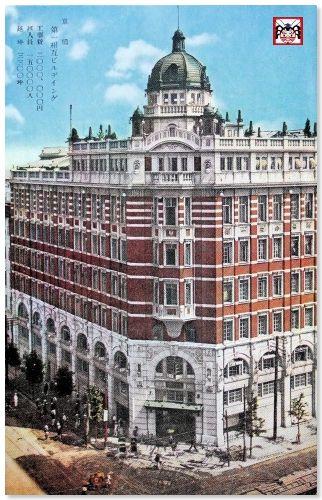
This building was designed by Kingo Tatsuno, famous for the station building of Tokyo Station and the head office of the Bank of Japan. It is a building owned by Dai-ichi Life Insurance and is named "Daiichi Mutual House". Construction began in 1915, the year after the completion of Tokyo Station.
At that time, the high-rise buildings around this area were five stories, including the Mitsukoshi Main Building in Nihonbashi and the Okura Gumi Main Building in Ginza. Once the first mutual building is completed, it will be a large building with a seven-story building that exceeds that and a height of 45m to the rooftop tower.
At that time, it was a booming era brought about by World War I, but construction was difficult due to a shortage of building materials due to inflation, and it took two years to build steel frames. As you can see, there is a steel-framed first mutual hall that boasts an unusual height, but it seems that it was sometimes called a haunted house due to the interruption of construction.
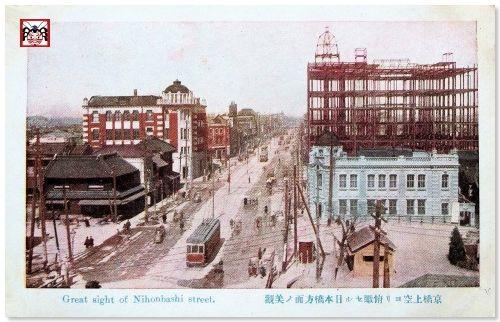
Meanwhile, Kingo Tatsuno died suddenly without waiting for completion. In March 1919, it was just 100 years ago. Due to the subsequent recession, construction work is extremely difficult.
While the first mutual hall was under construction, in May 100 years ago, a celebration tower stood in Kyobashi. This celebration was called the three major celebrations. It is a celebration that combines the adult ceremony of the Imperial Highness of Higashimiya, the 30th year of municipal organization, and the 50th year of Dian capital. His Imperial Highness Higashimiya was later Emperor Showa, and at this time he was 18 years old.
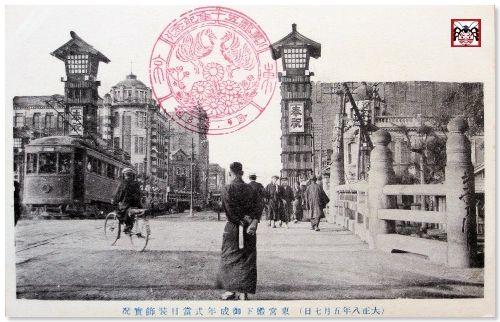
On the right side of the street is the first mutual building under construction, but on the left side of the street, construction of the building has begun behind the Daido Life Building. The building, which was originally a four-story building, is being renovated into a seven-story building, and seems to have been completed this year.
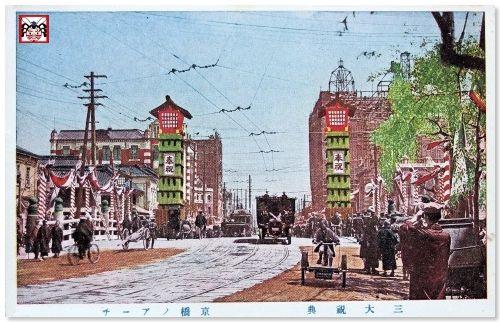
This building was built at the head office of Hoshi Pharmaceutical, an emerging pharmaceutical company, and was built by its founder, Hajime Hoshi. Hajime Hoshi was a person who started this company after studying abroad in the United States, demonstrated management skills such as adopting the method of a dealer for the first time, and pushed this company to a pharmaceutical company called Toyoichi.
Hajime Hoshi's son is Shinichi Hoshi, known as a science fiction writer, but the fate of Hoshi after that can be heard from the sad story he wrote.
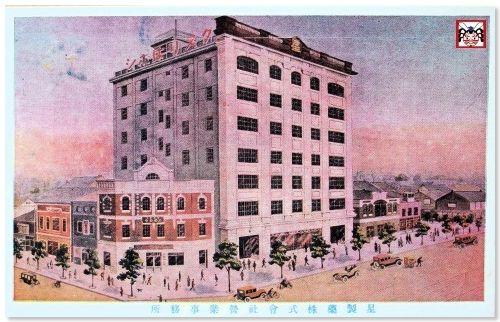 This building was built diagonally opposite the first mutual building under construction. From the Ginza side, it is characterized by the shape of a window close to a square, and after this, it often appears in the landscape of postcards. On the rooftop, the signboard "Kusuri wa Hoshi" glowed in red letters. This building was built diagonally opposite the first mutual building under construction. From the Ginza side, it is characterized by the shape of a window close to a square, and after this, it often appears in the landscape of postcards. On the rooftop, the signboard "Kusuri wa Hoshi" glowed in red letters.
After seeing the completion of such a Hoshi Pharmaceutical building, Kingo Tatsuno's work, Daiichi Mutual Hall, will finally be completed. The construction was uncompromising, three years behind schedule, and the construction cost was twice the budget and completed after hardship. It was in March 1921.
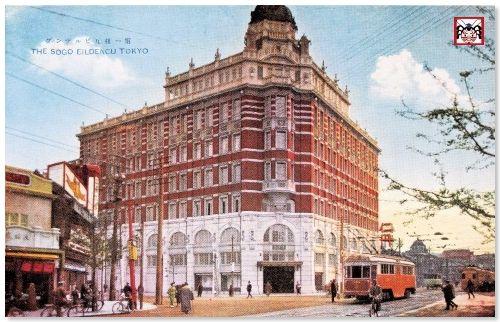
It was a building that made use of the classic red brick style, which is a characteristic of Tatsuno Kingo architecture, everywhere, but the biggest feature is the height of the building, which is 45m. From that tower, you should have overlooked the current entire Chuo-ku.
This photo shows the direction of Ginza as seen from the first mutual hall in Taisho 10 (1921).
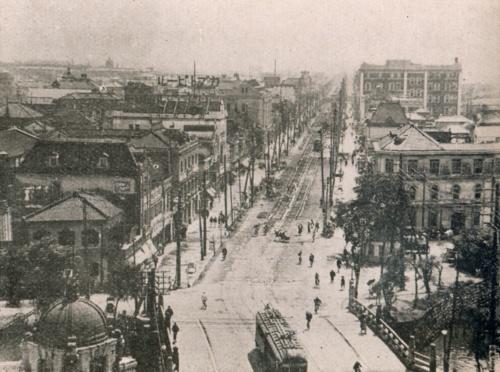 Photo provided: Chuo Ward Kyobashi Library Photo provided: Chuo Ward Kyobashi Library
As you can see, Ginza-dori curves at Kyobashi, so the rooftop of Daiichi Mutual Hall was a great location overlooking Ginza-dori from the middle. You can see that the only tall building that can be seen in Ginza at this time is the Okura Gumi Main Building on the right side of the street. At that time, Ginza was a time when cafes were very prosperous.
On the other hand, the view of Nihonbashi. It will also be around 1921. It seems that there are not many large buildings here too.
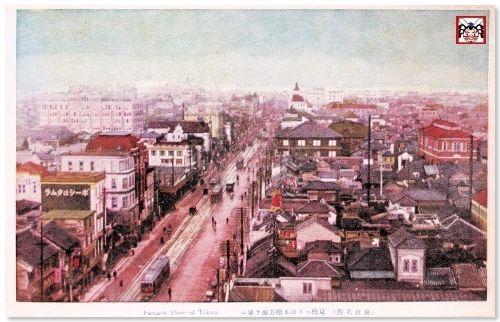
In the lower left, you can see Tamura's hat shop. The location of Konosu in the restaurant, where correspondent yaz, previously reported, seems to be near here. You can understand the situation at that time, so please take a look at it.
★The article by correspondent yaz → Here
And the postcard below, probably the scenery of Minami Temmacho seen from the Ginza side in Taisho 11 (1922) the following year.
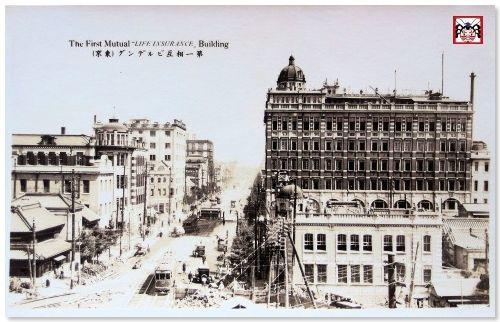
Minami Temmacho is transformed into a landscape of a big city. Among them, the "three dome roofs", which appeared in a short period of time, must have been seen as a symbolic building of Minami Temmacho from Ginza. In the meantime, there is a square building of "Thirty-four Bank" in front of the Daido Life Building, and a new building is under construction beyond the Hoshi Pharmaceutical building.
If you look closely in the foreground, you can also see that road construction is being done. Minami Temmacho entered the Taisho era and took a great look in the field of architecture, but that also responded to the field of civil engineering. This is probably the work related to the replacement of Kyobashi.
Kyobashi decided to widen the bridge in 1922 and stop the main pillars of the traditional Edo giboshi. And we decided to have a main pillar of modern design. I guess I wanted to have a modern design that matched the cityscape of Minami Temmacho. One of these main pillars is still left at the site of the Kyobashi site, so some of you may know.
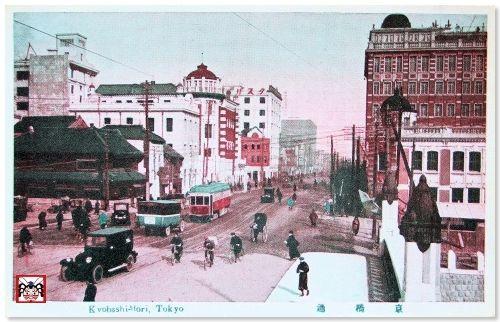
Looking at this way, the design of this main pillar is in harmony with the cityscape created by the "three dome roofs", and Minami Temmacho, which can be seen from the Ginza side through the main pillar, looks like a city heading to heaven, extending upwards.
There are many buildings around. The upper left building of the postcard is Katakura-kan (Katakura Life Building), completed in 1922, along the Kajibashi Bridge Street in the current Tokyo Square Garden, and until a few years ago it was the Katakura Industries Building.
On the other hand, the "Chiyoda-kan (Chiyoda Seimei Building)" is built at the innermost end of the street. Completed in 1923, the following year, it is the place where the current Kyobashi Trust Tower is built.
In this way, during the Taisho era, life insurance and financial companies were prosperous in the boom of World War I, and many high-rise buildings were built in Minami Temmacho ahead of Ginza. From our point of view today, the cityscape of Minami Temmacho made at this time is such as the full opening of the Taisho era romance, but it seems to have been known to the people at that time as a representative urban cityscape of Tokyo.
But after this, Tokyo and Minami Temmacho will be attacked by the events of that day.
Followed.
[Sumida Fireworks]
February 6, 2019 18:00
The story of Kyobashi. It is a continuation from the last time (Click here last time → [Kyobashi Monogatari 1]).
It is the city of Kyobashi seen from Ginza. The Kyobashi River used to flow at the border between these two towns, and Kyobashi was built on it. The main pillar of the bridge built in the Meiji and Taisho eras is left as a historic site, but it is no longer difficult to imagine that era from the current cityscape.
 However, the city of Kyobashi seen from Ginza was once known as a picturesque landscape. What kind of city was it? How did the cityscape be created? I would like to introduce it in several times using postcards. However, the city of Kyobashi seen from Ginza was once known as a picturesque landscape. What kind of city was it? How did the cityscape be created? I would like to introduce it in several times using postcards.
I'm going to start talking with a single photo.
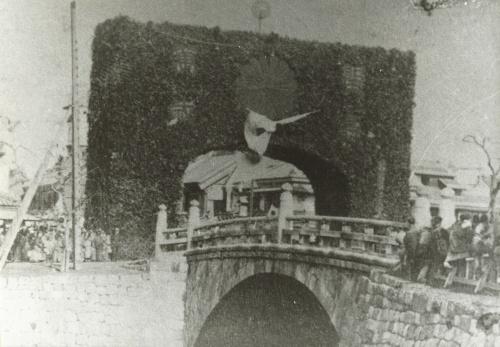
Photo provided: Chuo Ward Kyobashi Library
I see "Kyobashi" that spans the Kyobashi River from the Ginza side. At that time, in 1895, the street of Kyobashi was named "Minami Temmacho", and a huge gate temporarily stood on the south Temmacho side of the bridge. This is a triumphal gate built during the Sino-Japanese War. It seems that triumphal gates in various shapes were built all over the country to welcome the soldiers who went on the expedition.
On the other hand, "Kyobashi". The Soseki is said to be in the early Edo period, but the bridge in this era was replaced from wooden to stone by Kangoro Hashimoto, a famous mason in Higo, Kyushu in 1875. The main pillar of this bridge, which drew a stunning arch, had the traditional design of the Kyobashi giboshi.
Kyobashi later replaced an iron bridge in Meiji 34 (1901). It is said that the main pillars and balustrades were diverted from the previous Ishibashi, and the side of the arch was covered so that the structure inside could not be seen, and the pattern was applied.
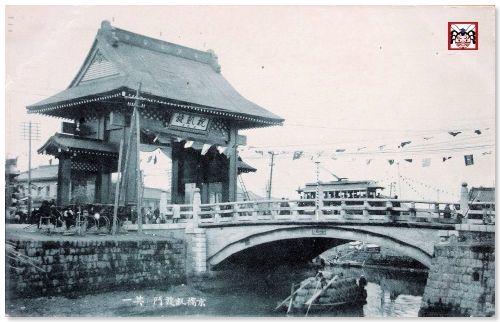
The Japanese-style gate on the left is the Kyobashi Arc de Triomphe, which was built around 1905 during the Russo-Japanese War. The one with the Arc de Triomphe is on the Ginza side. A tram runs on the bridge, and a small boat carrying rice bales floats on the Kyobashi River.
This is a postcard. When the postcard was approved in 1900 (Meiji 33), the postcard became popular with the victory mood of the Russo-Japanese War. At this time, there was no radio yet, and postcards played an important role as a means of communicating information to various places. And that information has been delivered to the present at different times in the form of valuable historical materials from the early 20th century.
Streetcars are often reflected in postcards on Ginza Street. After replacing Kyobashi with iron, the tram began passing in Meiji 36 (1903), so postcards began at a time similar to the history of iron Kyobashi and Ginza Street tram.
This is a view of Ginza Street in the Arc de Triomphe from Minami Temmacho. As the flag flutters, flower trains run, and the people are rushing on the bridge. The appeal of postcards is that you can enjoy the atmosphere of the time, which cannot be learned in history textbooks.

I still have the charm of postcards. Occasionally, interesting things are shown. This is a postcard with a view of Minami Temmacho from Ginza. There is a gas lamp on the right end, and a telephone box is on the lower left.

For the first time, I learned about the phone box in an article previously reported by correspondent Hanes. Please take a look at it.
It was in Kyobashi! Japan's first street payphone → Here
By the way, this postcard is called "hand-colored postcard", which is colored by a coloring teacher on each one. I don't know if it was the real color because it's sometimes painted with the person's favorite color.
If you look closely at the distance in the upper right corner of the phone box, you will see the clock tower. This is Kobayashi Clock Store in Minami Temmacho. Kobayashi Clock Store is famous for its large clock tower built in Hachikan-cho (now Ginza 8-chome), and a clock tower was also built at this branch in Minami Temmacho. Kintaro Hattori, the founder of the Hattori Clock Store, saw the prosperity of this Kobayashi Clock Store, and decided to become a watch dealer.
The picture postcard below is probably the scenery of Minami Temmacho in the late Meiji era. On the other side of the bridge is the beer hall in Minami Temmacho, and on the far right is the main pillar of Kyobashi with the word "Kiyahashi" and something like a gas lamps.

At the current site of Kyobashi, there are two main pillars engraved with "Kiyauhashi" and "Kyobashi", but as you can see, the place where it was actually installed at that time was "Kiyauhashi" was on the right side from the Ginza side, and "Kyobashi" was on the right side just before the Minami Temmacho side.

By the way, when I looked into past photos of the two main pillars, one seemed to be the bridge year of 1901, and the other seemed to have some characters carved, but I could not decipher it.
After that, we entered the era of the Taisho era. This photo seems to be around Taisho 2.3 (1913.4). This is a photo of Ginza from Minami Temmacho. The building on the right side is Nissha. The current Yomiuri Shimbun was here.

Nissha had a clock tower at the end of the Meiji era, but it was removed in a few years. The city of Ginza was a place where many Meiji period and newspapers gathered, and it was also a center of information.
On the other hand, on the Minami Temmacho side, in 1914, a building of Toyokuni Bank Kyobashi Branch was completed on the diagonal line of the Nissha Bridge. It is around the building where the current LIXIL is built.

The design of the postcard is probably the scenery seen from the tower of the circular dome. Since this building was built in the Taisho era, the city of Minami Temmacho will blossom at a rapid pace.
The following year, Kyobashi was built in 1915, but there is a memorial gate on the Minami Temmacho side and a memorial tower on the Ginza side. One of the major bridges, including Kyobashi, was built with some big celebration.

This is a postcard of the Emperor Taisho's great lord (the throne and Great Thanksgiving Ceremony) was held in November. What is drawn on the stamp is the octagonal Takamikura, which is used in the throne of the throne at the time of the succession of the throne. It seems that the current Takamiza was reproduced at the time of the Emperor Taisho, and this will be used again this year.
Looking at Minami Temmacho from a different angle, the Toyokuni Bank is shown on the right side of the street, and the construction of a new building has begun opposite it.

This is the building of Daido Life Insurance Tokyo Branch, completed in 1916, the following year. It was called "Daido Life Building" and had a circular dome roof similar to Toyokuni Bank. After this, it will become a building that will be the face of Minami Temmacho, which creates the atmosphere of Taisho Roman. In terms of its current location, it is located on the ground floor of Tokyo Square Garden, above Central FM.
 Photo provided: Chuo Ward Kyobashi Library Photo provided: Chuo Ward Kyobashi Library
Is it around 1916? The bridge seen from this Daido Life Building and the cityscape of Ginza.

Minami Temmacho, where tall buildings began to be built. You will be able to get a bird's-eye view of the city of Ginza from a high place, and this kind of photo will appear in the future. In the Taisho era, Minami Temmacho began this way.
Followed.
1
|
Links
|

 Hoshi Pharmaceutical buildings, which had been damaged by the earthquake, have been renewed, and the reconstruction of the city of Minami Temmacho has ended for the time being. Nevertheless, the cityscape of Minami Temmacho, which retains the remnants of the Taisho era. People walking on Ginza Street may have felt a kind of nostalgia.
Hoshi Pharmaceutical buildings, which had been damaged by the earthquake, have been renewed, and the reconstruction of the city of Minami Temmacho has ended for the time being. Nevertheless, the cityscape of Minami Temmacho, which retains the remnants of the Taisho era. People walking on Ginza Street may have felt a kind of nostalgia. This year when Ginza Mitsukoshi also opened at the 4-chome intersection. There was a change in the town of Ginza. Ginza, which was up to 4-chome, expanded to 8-chome, and the location of Owaricho, where the Matsuzakaya Ginza store was built, has been changed to Ginza 6-chome.
This year when Ginza Mitsukoshi also opened at the 4-chome intersection. There was a change in the town of Ginza. Ginza, which was up to 4-chome, expanded to 8-chome, and the location of Owaricho, where the Matsuzakaya Ginza store was built, has been changed to Ginza 6-chome.
















 The building on the left is Katakura-kan, and the right is star pharmaceutical with a diagonal window. The Katakura-kan will continue to expand and grow, but the Hoshi Pharmaceutical building has been damaged and will be rebuilt after this. The Kajibashi-dori, which runs in the middle, will be widened by the earthquake reconstruction project.
The building on the left is Katakura-kan, and the right is star pharmaceutical with a diagonal window. The Katakura-kan will continue to expand and grow, but the Hoshi Pharmaceutical building has been damaged and will be rebuilt after this. The Kajibashi-dori, which runs in the middle, will be widened by the earthquake reconstruction project.








 This building was built diagonally opposite the first mutual building under construction. From the Ginza side, it is characterized by the shape of a window close to a square, and after this, it often appears in the landscape of postcards. On the rooftop, the signboard "Kusuri wa Hoshi" glowed in red letters.
This building was built diagonally opposite the first mutual building under construction. From the Ginza side, it is characterized by the shape of a window close to a square, and after this, it often appears in the landscape of postcards. On the rooftop, the signboard "Kusuri wa Hoshi" glowed in red letters.




 However, the city of Kyobashi seen from Ginza was once known as a picturesque landscape. What kind of city was it? How did the cityscape be created? I would like to introduce it in several times using postcards.
However, the city of Kyobashi seen from Ginza was once known as a picturesque landscape. What kind of city was it? How did the cityscape be created? I would like to introduce it in several times using postcards.












